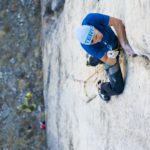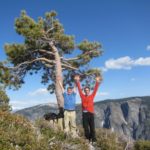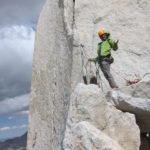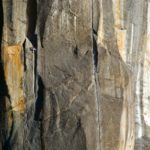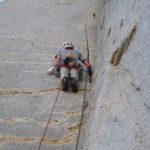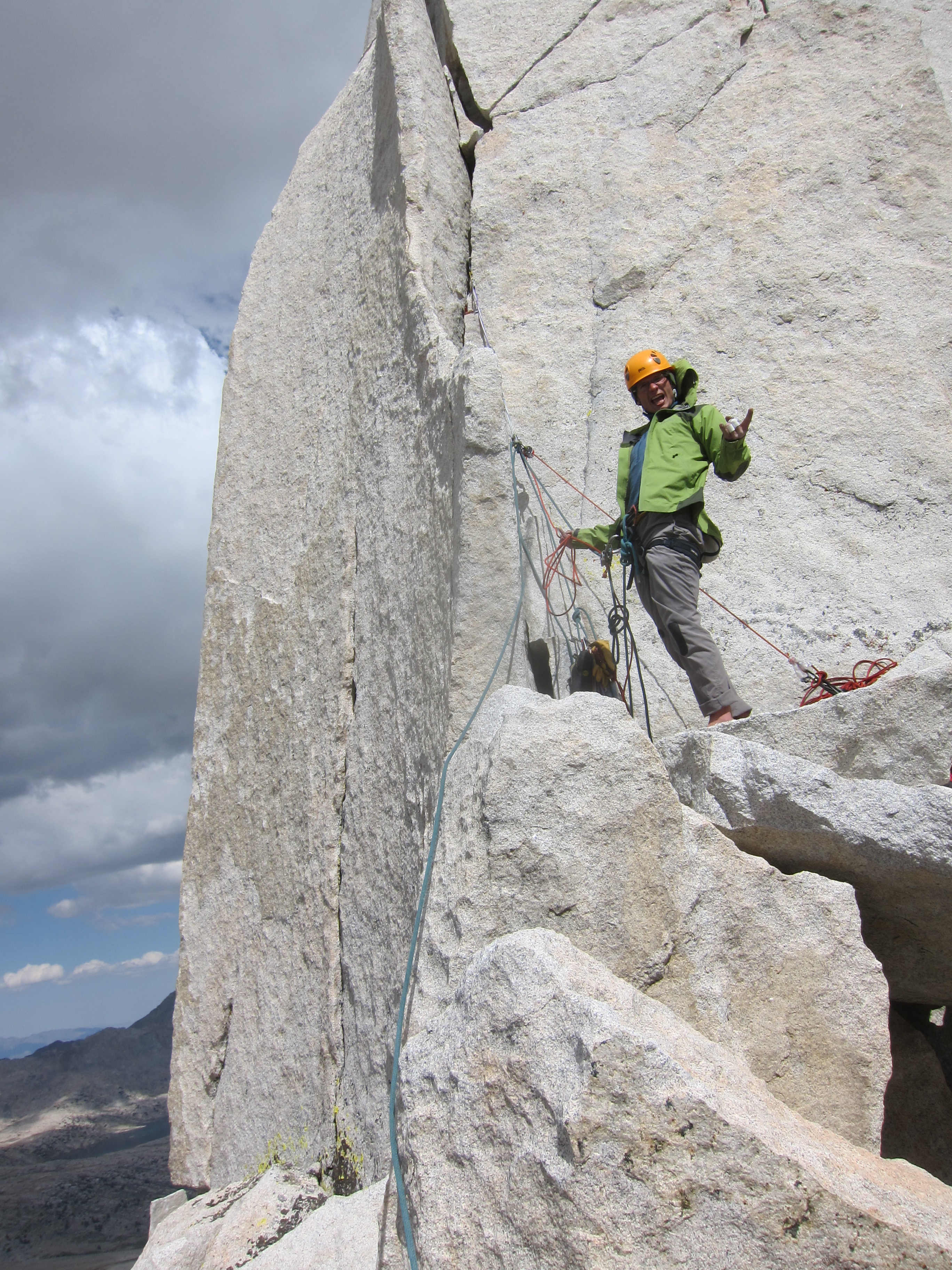
What is so cool about first ascents?!?
I’ve been pondering this question as I put words to my Forth of July climbing trip. Adventure, first ascents and the going into unknown all require work, frustration and a willingness to fail. It is easy to go to the gym every week or to look at a guidebook and go cragging. Instead I read stories about far away rocks, look at pictures, and hope that the features all connect. In some ways trying for a first ascent is a release, a way for me to get away from the numbers of climbing, the need for progress and success. Going on an adventure puts climbing back in my terms and I am able to set reasonable expectations and push myself in new ways.
The most obvious reason I think most people shy away from first ascents is that you aren’t always rock climbing. Pure climbing time is sacrificed for hiking, cleaning and some times bolting. One only has an idea of where to go but nothing is certain and time is spent figuring out the best way up.
Merriam Peak from the approach.
This year Forth of July weekend gave me the rare opportunity to take a five day trip. Extra time means going to the east side of the Sierra and taking a nice hike into the back country. Casey and I shouldered super heavy packs with a full compliment of brushes, hammer, drill and food for many nights in the Royce Lakes Basin. Luckily we were met with overcast skies as we trudged up the murderous grade from Pine Creek Canyon. Four thousand feet of gain in less than 10 miles was a serious undertaking and it was great that we had nothing planned for the first day. Basecamp was at 11,700 feet and insured that we would have a restless night of sleep.

We approached Merriam Peak from the Pine Creek Canyon Trail head
The planning for this trip had been motivated by a few trip reports on Supertopo and a sweet photo of the upper headwall/west face of Merriam Peak. At a minimum we would go and climb the two Croft-Rands routes, The Flying Buttress and Gargoyle. The real goals was to do one or two new lines on the right side of Merriam. It looked like there were a few continuous crack lines and I was hopeful that the route finding would be pretty straight forward…
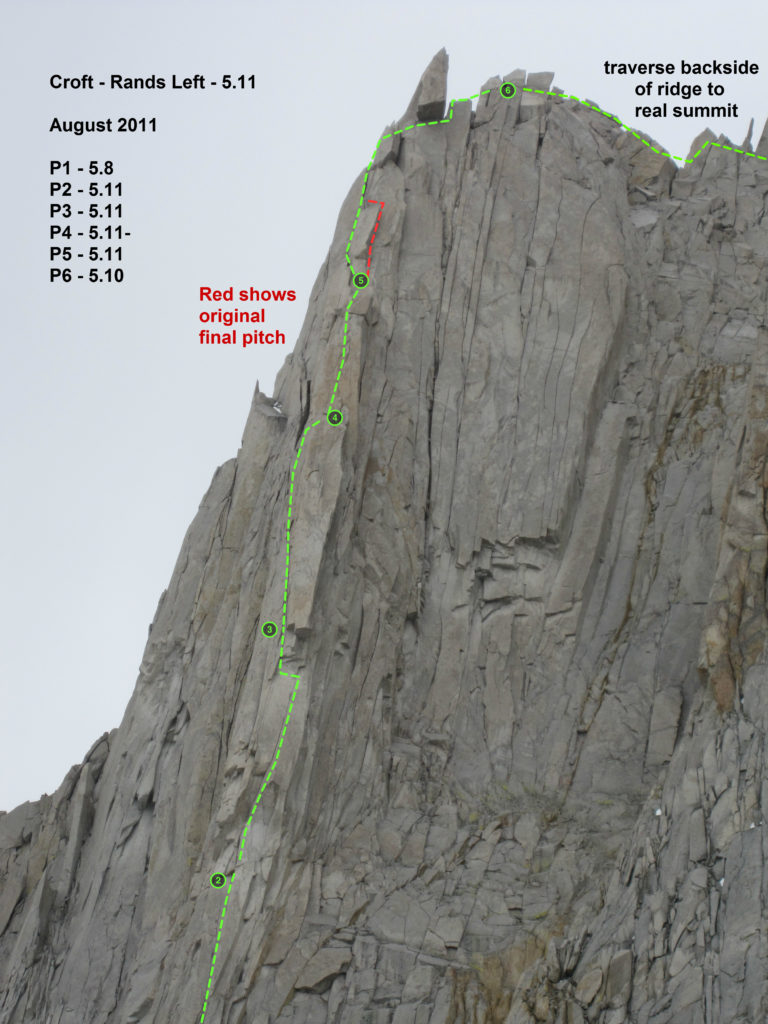
The Flying Buttress aka Croft-Rands Left and the West Face of Merriam Peak
Setting up camp was easy and in no time we were boulder hopping with a camera and binoculars to scout out a new line. From a distance it was hard to tell which features were cracks versus a shadow or a lichen filled groove. We decided on “the mama crack” on the far left side of the head wall since it looked to be the most accessible from the ground. With the plans set Casey and I returned to camp and racked up for the next day. Despite the early hour I was psyched to get to sleep and try to rest up for the long day ahead. It had been a hectic week and my sleep debt was high, the 8pm bedtime was well received.
The morning started at our own pace and the crowds we had seen on the hike in were long forgotten. A stiff breeze kept things chilly as we worked our way towards the shady face. Altitude was our top priority, so we 4th classed up a gulley as high as possible before cutting across towards the “headwall”. I lead a long pitch of loose and dirty rock with a few points of aid to get us established on the large broken ledge below the headwall. Despite some energizing climbing the cold had stayed with us and it was nice to have plenty of jackets.
Looking up at the 2nd pitch of the Dr. Bearlove Project
Casey set off into the unknown with hope that the thin seam (seen above) was a wide enough to allow passage to the large crack system above. Initially Casey has been free climbing but switched to full aid mode once the fingertip crack steepened. The passage of time was no longer measured in feet but by the rays of the approaching sun.
By the time I started climbing the the bright California sun was warming the rock, a pleasant change from the morning. (Sun hit the wall around 1pm on 7/5/2012) The initial section of thin crack was exciting and I was able to free climb while following. Eventually the angle steepened and the foot holds started to disappear. The final six feet of the crack required me to pull on gear before the crack opened back up to fingers. Switching from aid mode I employed creative stemming to reach Casey’s belay at the base of a very flared corner.
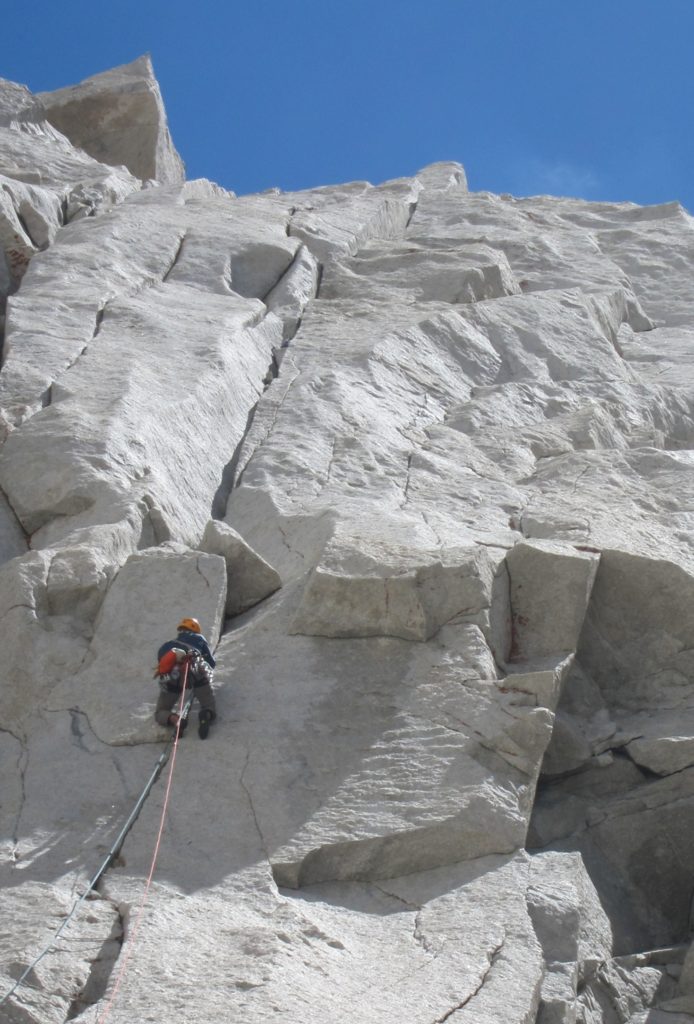
Casey aids the crux overhang of the second pitch.
The next pitch was the dirtiest of the route and much time was spent scraping small rock chips and lichen from the crack. Aid was my primary means of progress. About 75 feet above the belay I was able to free climb, which allowed for much faster progress to the next alcove and another belay.
The first 30 feet are the obvious crux of the third pitch since the crack is barely big enough for fingertips. Casey took the strong man approach and tried to layback up the flaring crack. This seemed to work for five to six foot sections before a foot slip would cause a sudden fall. Higher up the difficulty eased and Casey was able to free the second half of the pitch at ~ 5.10.
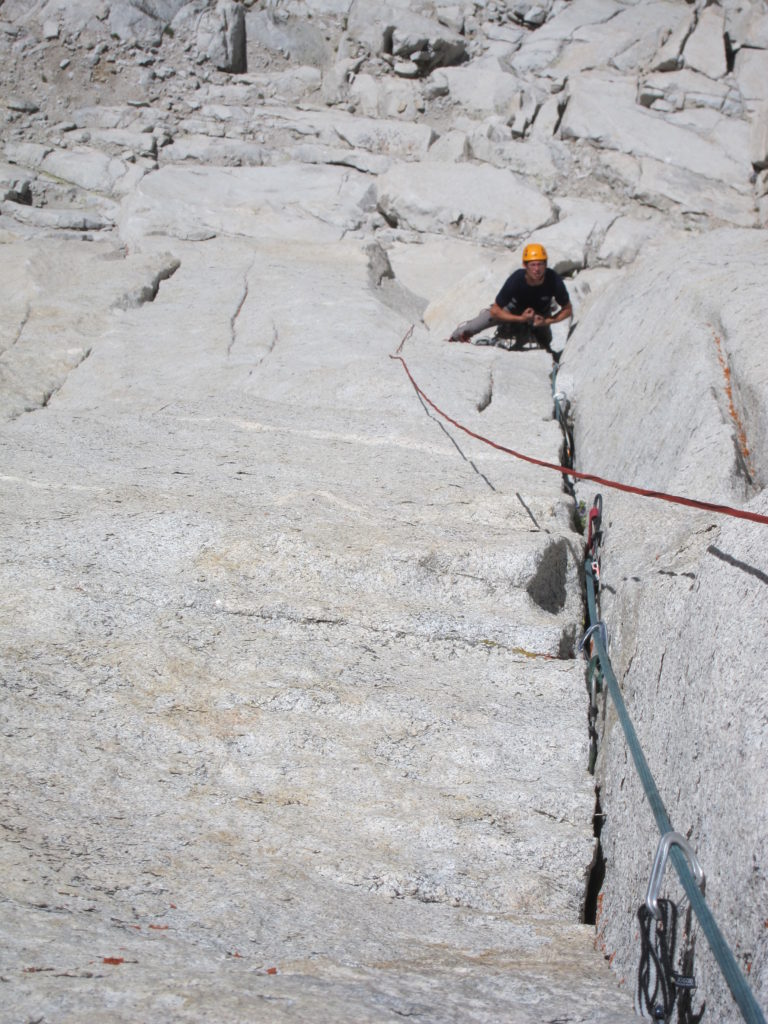
Looking down on the 3rd pitch
The quality of the granite had been good but usually covered in lots of small potato chip flakes. As we got higher the crack started to become a much better size for free climbing and the last pitch appeared to be the best yet. Casey took the lead and started jamming up the hand crack. Small flakes were raining down constantly as he went higher and higher. The pitch ended just shy of the summit ridge on a spacious ledge. Casey had climbed the pitch completely free! Nothing quite like an onsight FA at nearly 13,000 feet!
The crack was hand sized and I motored up the crack as fast as my lungs would allow. The pitch was phenomenal and will be even better with traffic. After a clean section of perfect hands was the crux of the pitch, a bulge with flared hand and finger jams. Reaching Casey’s belay was slightly bittersweet. I was psyched for the exploration and ascent of our new route, the Dr. Bear Love Project, but sad that it seemed to be out of reach of our free-climbing ability. The route was named in honor of Dr. Clinton Hart Merriam and The Oatmeal.
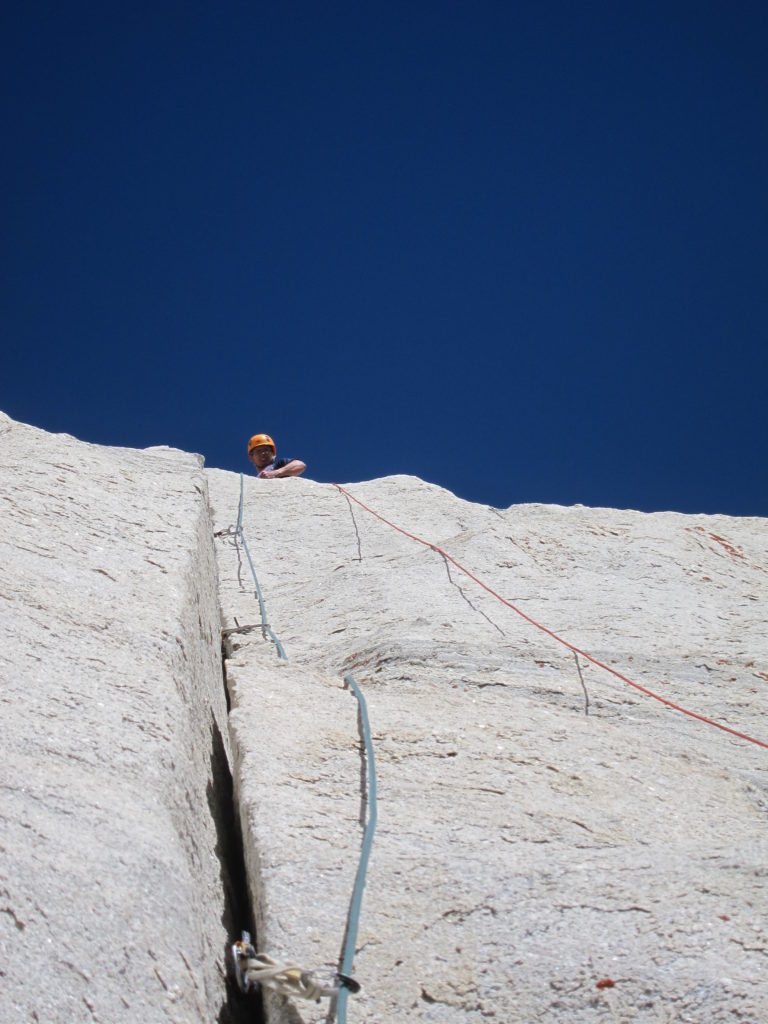
Casey near the summit after a proud onsight lead!
Before we could go down I was determined to do some recognizance on the far right side of the wall. From the ground it appeared that three amazing cracks split the upper headwall. From Casey’s belay I traversed, set a few pieces and then had him lower me sixty meters down the face. I swung around and then started climbing the killer hand crack (blue line in the photo below). It was dirty and covered in both lichen and small chips of granite, but I was able to make about 60 feet of progress before the size and steepness of the crack shut me down. After a few attempts at cleaning and climbing the right crack I swung left to the parallel crack (yellow line below). I was able to take this up back up to the top at a more reasonable grade 5.10/11.
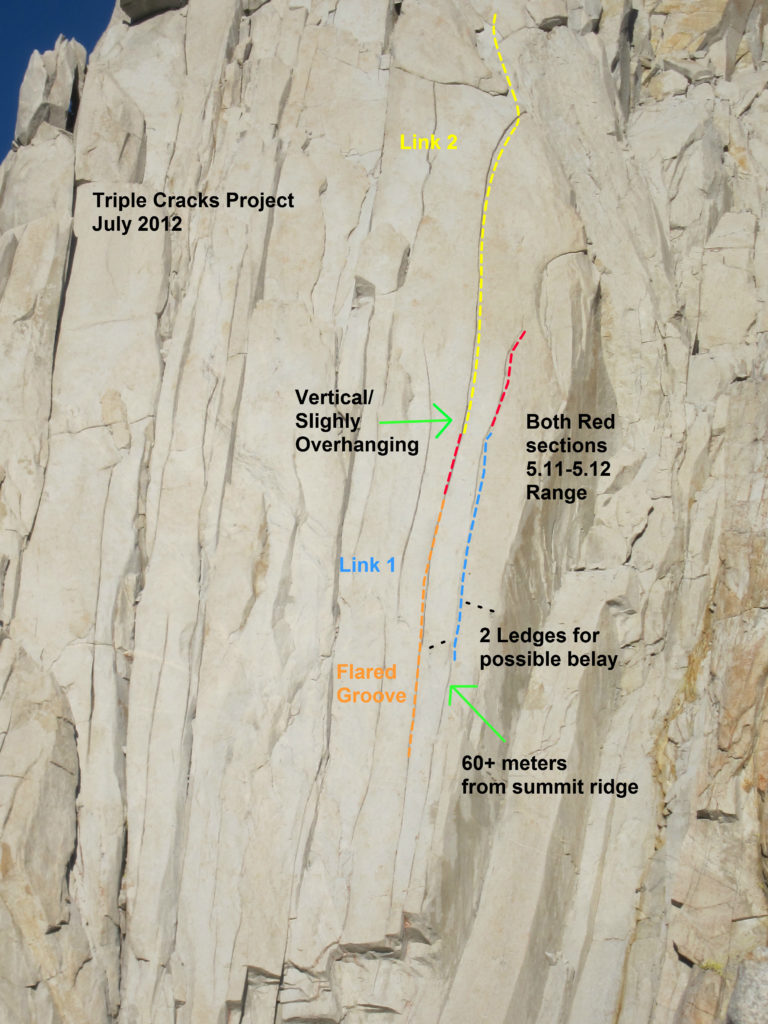
My attempts at the Triple Cracks
Back on the summit ridge we had to get moving since there was still a couple hundred feet of traversing and climbing to go. The sun had started sinking to the horizon and I expected we would be finishing the descent in the dark. With little fanfare we made it to the summit and figured out the route back to our home base near the lake.
As soon as we reached camp sleep came fast. Despite the short number of pitches, it had been a long day with two plus hour leads for both Casey and I. The reward was a new line, maybe free climbable, but definitely at the extreme limits of our ability. I wager the crux second pitch is 12c at a minimum and most likely somewhere around 5.13a, with a 10-20 foot crux section. The next pitch should go at hard 5.11 or easy 5.12 and the last pitch went free at 5.11a.
Lookingup at the start of The Flying Buttress.
With a large amount of doubt around the immediate feasibility of the Dr. Bear Love Project we decided to climb the The Flying Buttress. This route features a steep roof hand crack on the 3rd pitch, which had been described as one of the best in the Sierra. With topo in hand and less unknown variables we worked our way back up Merriam. I would lead the first two 5.11 pitches and Casey would get the second two. Tip toeing through the occasional broken rock and shattered granite it was clear that this route was newly climbed. We trundled what we could since there was no one else climbing in the area.
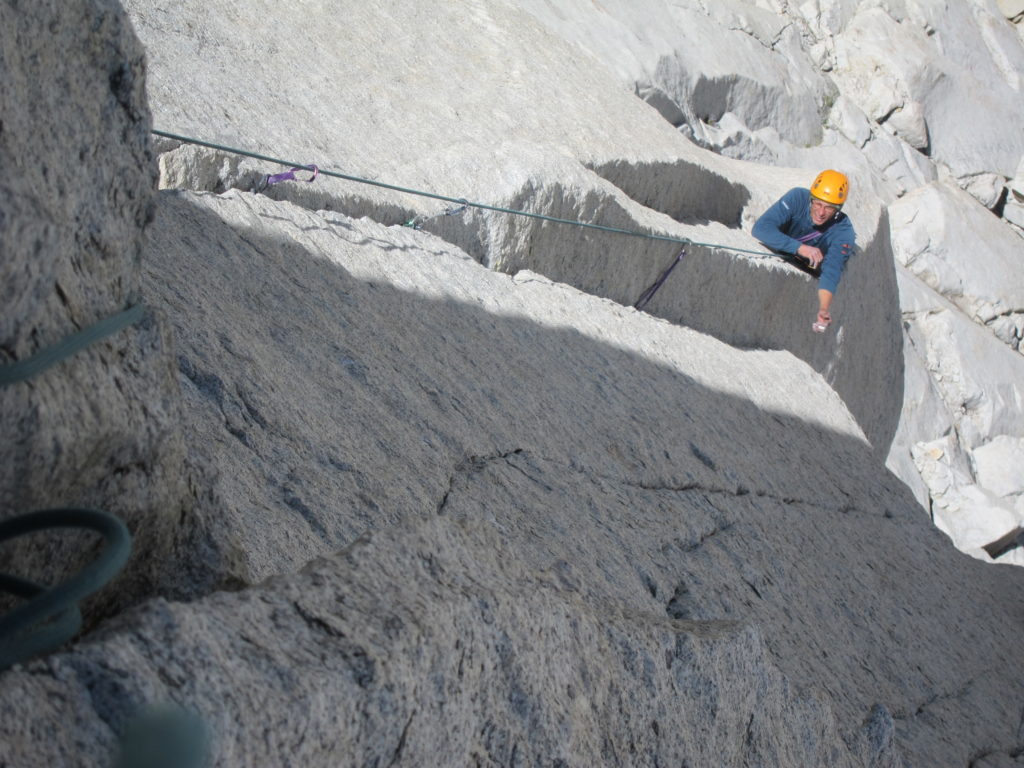
Casey is ready for glory hands!
Pausing with my feet next to a piton, that provided the sole protection for this section, I punched it to a series of sharp fingerlocks and abundant gear. Still pumped I continued up sweet thin hands over a bulge that lead to super clean granite and the anchor below a small roof. Casey followed without issue, cleaning some large hanging teeth, and I was climbing again in no time.
A splitter 4″ crack gave way to perfect hands and an awesome stance before the business. The crack jogged horizontally for 10 feet and again I put on my try hard face and gunned the rest to a stance at the end of the roof crack(seen above). Little did I know that there was more hard climbing yet to come. Glory hands gave way to a tricky face traverse (video below) and another small roof. Bits of lichen and granite rained on me as I tried to get my jams to stick. Pumped to the max I went into survival mode and heaved myself over the baby roof. An explosion of grunts kept the send in the bag as I made my way to a ok stance and a belay.
Sweet Face Traverse. (Video contains adult language)
With the supposed crux pitches behind us Casey set off on another pitch of stellar steep climbing. The cracks were getting cleaner and this pitch climaxed with dueling finger cracks, face holds and amazing movement. We had made it back into the sun and on a nice sloping ledge. A 40 foot wall of golden granite was the next course in the already phenomenal set of pitches. As said by Croft:
“A pitch higher we ran into another discontinuity: a 40 foot vertical headwall of orange ripples above a big ledge. Fortunately for my nervous ankles, a few decent gear pods showed up, but I still overgripped the twisty-turny holds and huffed and puffed.”
Casey post crux on the golden headwall!
I thought that this short section was the mental and technical crux of the route. Perfect choreography was necessary as Casey arranged tricky protection while fighting the pull of gravity in the thin alpine air. This short section of rock was the stage and Casey danced his way up. Gear was sparse and I was hopeful that the protection he placed was sufficient to keep him off the ledge. As finger pods opened up, hope grew and the final sequence revealed a glory jug at the top of the wall. I followed with difficulty, crimping the small undulations in the wall and made one step closer to the summit. Before the belay (seen below) was a final challenge of walking the plank. There was a 10 foot gap between me and casey that was filled with various sized chalkstone, stacked precariously like the tower in Jenga. Care was essential to our passage up the route.
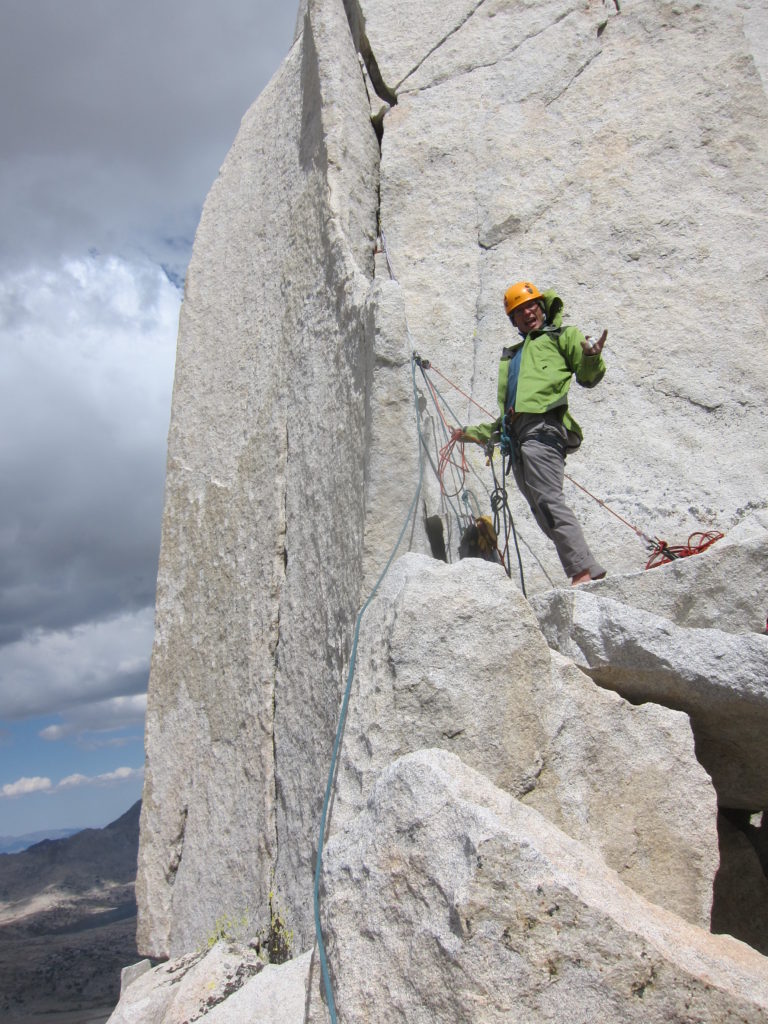
Casey is psyched for the glory pitch to the summit.
Our excitement was bubbling over as I swung through and charged. Time spent at the Yosemite School of Wide helped me quickly dispatch the offwidth on the final pitch and soon I was running across the traverse to the ridge-line. It had been an amazing no-falls day on a superb route. It seems that we had made the 3rd ascent and I couldn’t wait to share the tale. The route was just soo good and presented a perfect amount of spice and difficulty.
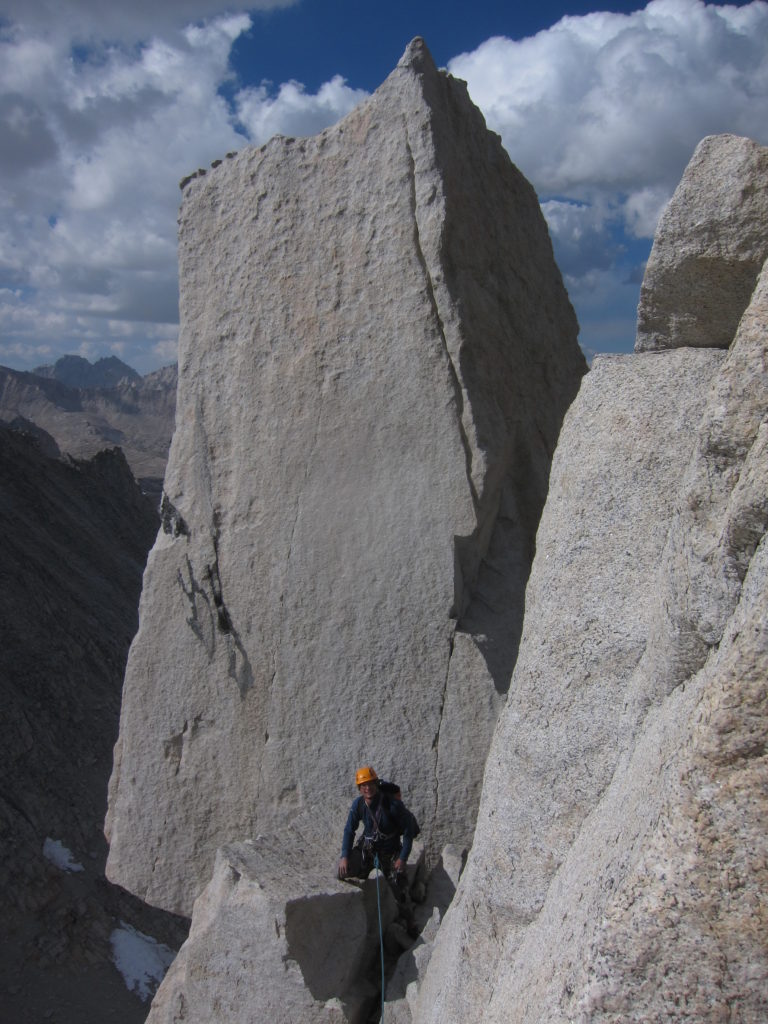
Behind Casey is the huge capstone that you must traverse underneath.
The next day my energy was tapped, I was missing my sweetheart, and no longer had the drive to push my limits. The right Croft-Rands route, Gargoyle, would have to wait and I convinced Casey that we should do a quick lap up the North Buttress. The weather had been improving each day and we had been taking less and less cold weather gear. Racking up in the sun at the base I didn’t put enough thought into the shady aspect of our chosen route. As the pitches passed by we were chilled to the bone on the North Buttress.
For the first time all weekend we had company at Merriam and two other climbers had rallied to climb the North Buttress. As the day passed by the four of us inch wormed up the stellar route. The rock was often loose, and the climbing not as clean as the Croft route, but the position was astounding. Most impressive was the steepness of the majority of the pitches. It was crazy to climb overhanging cracks at 5.8 and 5.9. As well, many pitches looked intimidating from below, only to become stellar cracks once you started climbing them. The North Buttress is a classic route with an alpine feel and a need to take care with the loose rock.
This route was also a great finale to our Fourth of July adventure “weekend”. I was psyched to have done a new route, despite our inability to free-climb the pitches. It seemed that there was more potential around, but the rock required much more cleaning than I expected. I highly recommend the The Flying Buttress , more info and beta can be found on Mountain Project.
Thanks for reading,
Luke
